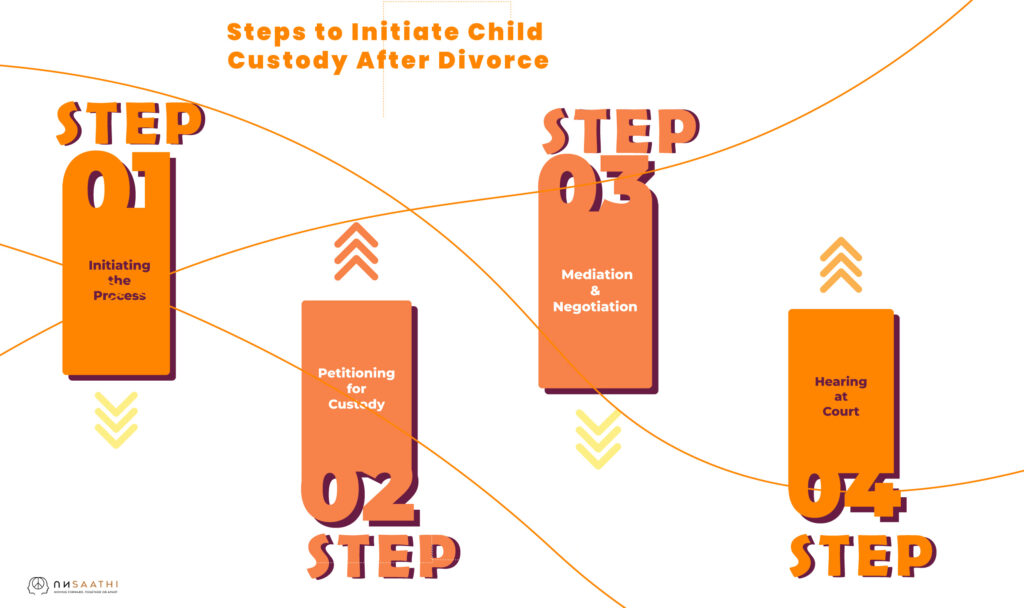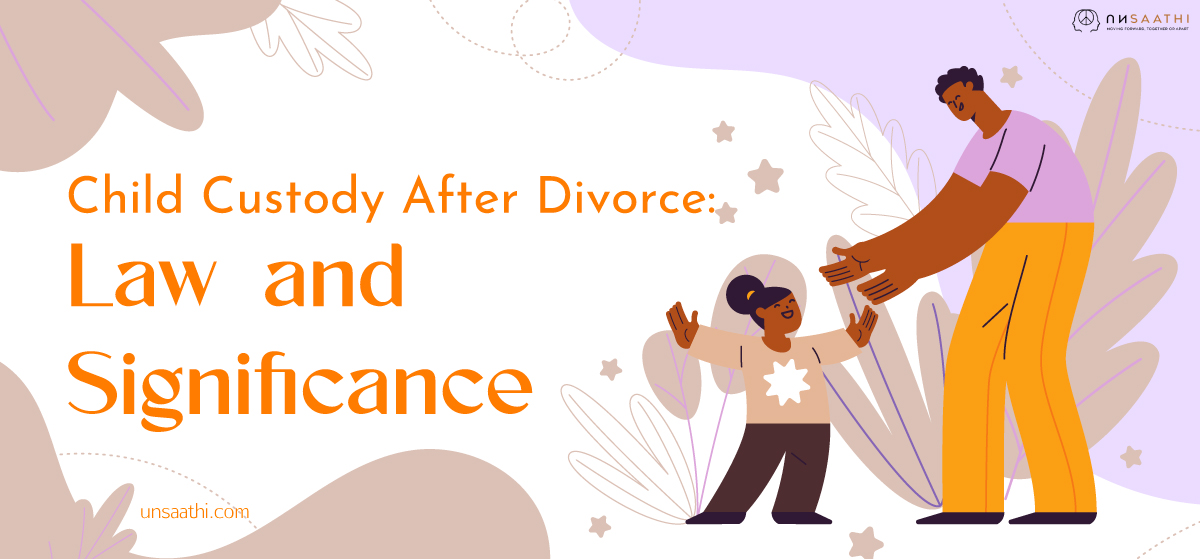Child Custody After Divorce: Law and Significance

Divorce is one of the more emotionally and psychologically taxing experiences in life, especially if children are participants. It can be a complex process, especially regarding child custody arrangements. Custody arrangements play a critical role in ensuring the child’s well-being, and parents must work together to navigate the legal complexities and emotional challenges that arise to ensure the child’s best interests are prioritized.
This article serves as an all-encompassing guide to child custody after divorce, raising awareness of the three custody classes, the court process, determining factors for courts, and some general tips for parents experiencing this life change.
Child Custody: Its Meaning and Types
Child custody refers to the legal rights of parents after they divorce or separate from each other.There are different personal and customary laws that govern the child custody after divorce.
The Hindu Minority and Guardianship Act, 1956 has the provisions for child custody after divorce for the Hindus, whereas the Guardian and Wards Act, 1890 governs the child custody provisions for other communities. According to the Muslim Personal Law (Shariat), the child custody or Hizanat is usually granted to the mother , whereas the father attains the visitation rights.
There are two main components of the child custody after divorce : physical custody and legal custody.
Physical Custody: Refers to a parent’s right to have the child reside with them. Joint physical custody means the child lives with both parents at different times, while sole physical custody means the child has a primary residence with one parent.
Legal Custody: This allows the parent to make significant decisions in the child’s life, such as their education, health care, and religion. Legal custody is often awarded to both parents or given only to one parent.
Types of Custody Arrangements:
Sole Custody: One parent has both legal and physical custody, while the other parent may be granted visitation.
Joint Custody: Legal and/or physical custody is shared between parents. Joint custody is preferred, but the child’s best interests take precedence.
Bird’s Nest Custody: With this arrangement, the children stay in one family home, and the parents take turns living there. This is rare but can be an option in some instances.
Steps to Initiate Child Custody After Divorce
Step 1: Initiating the Process
The parents are forced to go to court for a ruling when they can’t agree upon the custody of their children. While this process can differ in each jurisdiction, it generally includes numerous critical steps;
Step 2: Petitioning for Custody
One of the parents needs to file a custody petition in family court. This document is a parent’s petition for custody and their reasons why they want what they request.
Step 3: Mediation & Negotiation
Before a trial with parents going to court, judges frequently persuade mediation. Although less adversarial than litigation, mediation also has both parents working with a neutral third party to come to an agreement regarding a custody arrangement.
Step 4: Hearing at Court
In cases where mediation is not successful, a hearing may be held at the court, during which both parents present their own cases. The judge will look at the evidence, listen to the parents’ testimony, and might also hear testimony from witnesses and child psychologists.
The court shall determine child custody after divorce based on what is in the best interest of the child. The ruling can include joint or sole custody, visitation and child support, among other considerations.
How Judges Determine Child Custody?
Although custody laws may vary by jurisdiction, most courts use a similar approach to decide what is in the best interests of a child. Judges typically weigh the following factors in order to grant the child custody after divorce:
The Child’s Preference: Under some circumstances, when the child is of sufficient age and maturity (generally at least 12 years old), the court might also consider the child’s preference for where they want to reside.
Parental Fitness: The psychological, emotional, and physical fitness of parents impact this factor severely (and how). Courts determine whether each parent is capable of meeting the child’s needs, including whether they can provide a stable, loving and safe environment.
Child’s Relationship with Each Parent: The nature of the relationship between the child and each parent is an essential factor to consider. Judges typically consider how well the child relates to both parents and which parent has been more involved in the child’s daily life in the past.
Ability to Co-Parent: The parents’ ability to cooperate and communicate with each other is a crucial consideration in joint custody cases. Courts tend to prefer parents who can make joint decisions that are in their child’s best interest, even if that includes people who are no longer romantic partners.
Primary Caregiver: If one parent has taken the lead on caring for the child (i.e., preparing meals, attending school functions, providing emotional support), this may also play a role in deciding custody for that parent.
Finding of Abuse or Domestic Violence: Any finding of a history of abuse, neglect or domestic violence by either parent is essential when determining custody. In these cases, courts will take action to protect the child’s safety and may limit or deny the abusive parent custody or visitation.
Stability of Each Parent’s Home: The court will evaluate both parents’ living situation as well. The cleanliness and condition of the home, the neighbourhood’s resources, and its stability all play a role in whether the particular home is suitable for raising the child.
Visitation right – Why is it essential?
Visitation rights: If one parent is awarded sole custody, the other parent may be granted visitation rights. Courts typically favour relationships with both parents and visitation plans will be tailored to ensure that the non-custodial parent continues to play a role in the child’s life.
When a couple separates, the need for a plan becomes crucial, especially when children are involved. Visitation rights help the non-custodial parent to nurture the bond with their kid. There are different personal and customary laws that govern child visitation right after divorce.
For example – The Section 26 of Hindu Marriage Act, 1955, provides for the visitation rights after divorce for Hindus, Sikhs, Jains and Bhuddhists communities. Further, there are different laws like the Special Marriage Act, 1954 and Hindu Minority and Guardianship Act, 1956, etc that provide for other communities.
Some important things to know about visitation:
Regular Visits: Visitations are generally scheduled at regular intervals, even on the weekends , holidays, and vacations. A visitation schedule tells the child when they will see the non-custodial parent, which often calms the child and gives them a sense of security.
Supervised Visitation: In situations where there are concerns regarding a parent’s ability to take care of the child (such as abuse or substance abuse situations), the court may order supervised visitation. In this case, the visits will happen in front of a third party, a family member, or an executive supervisor.
Parenting Plans (joint custody): A parenting plan is often required in joint custody and will outline how parents will make decisions and share time with one another. The time frame for visitation, transportation, and any other relevant logistical considerations will be outlined in the plan.
Challenges and Emotional Considerations in Custody Battles
Child custody after divorce disputes can be contentious, draining and complicated. This process can take a toll on parents and children alike. A few of the prominent challenges are:
Emotional Toll on Children: Child custody after divorce battles can take an emotional toll on children, who may feel torn between their parents and experience confusion, sadness, and anxiety. They might also worry about losing touch with one parent, and that can cause emotional and behavioural problems.
Parental Conflict: Hostile divorces are increasingly challenging to negotiate. This is called prolonged parental conflict, which can harm the child, and in extreme cases, parents use the children as pawns in the argument. Furthermore, parents could face the cost of finding attorneys or counsellors to help settle the dispute.
Parenting Strain : Even if they have been given child custody after divorce. Custody has been decided, and parents will continue to work on being the favorite of their child. Disputes about daily decisions, vacations, and holidays can cause ongoing stress and strife.
Tips for Parents Dealing with Child Custody After Divorce
Navigating child custody after divorce can be a complex process, but here’s some advice for parents to keep in mind:
Foster the Best Interests of the Child: Always put the child’s emotional, psychological, and physical health first. One way of avoiding a fixation on personal issues is for parents to remember that the primary consideration is their child’s well-being, and they should concentrate on a solution that will be in the best interest of everyone, including their child.
Consider Mediation: Mediation often allows for a less adversarial approach to custody disputes. This allows the parents to work jointly to develop a plan that is acceptable to both, without involving the court.
Stay Calm and Composed: Keep your emotions in check during the process. While it is expected to be angry, sad, or frustrated, the need to be calm and present a rational case in custody hearings is vital.
Seek Guidance from a Family Law Attorney: An experienced family law attorney can walk you through custody, explain your rights, and fight for your child’s best interests.
Child Custody After Divorce: Key Takeaways and Conclusion
Child custody after divorce is one of the most complicated and emotional aspects to navigate after a divorce. It is incumbent upon both parents to objectively assess and establish what is in their child’s best interest in the context of the law.
Knowing about the different types of child custody after divorce, the legal process, and the relevant factors to courts helps parents make informed decisions and ensure that the child’s needs stay at the heart of the process. Though there can be difficulties and emotional struggles along the way, with proper surroundings and assistance, parents can navigate custody resolution and establish a loving and stable home for their little ones.




